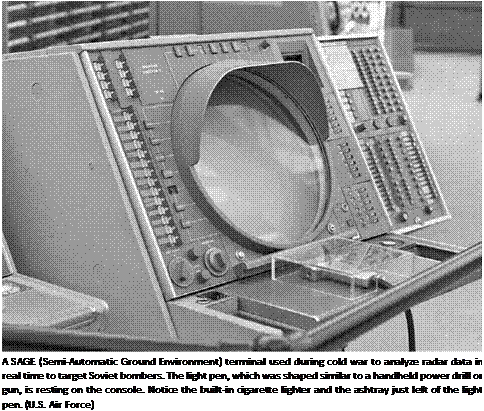1956
January 1 A milestone is passed as the 1000th Boeing B-47 Stratojet is accepted into service by the Strategic Air Command (SAC). It continues on as the mainstay of American nuclear deterrence until the larger and more capable B-52s are available in greater numbers.
January 17 In Washington, D. C., the Department of Defense declares that an automated, electronic air defense system called SAGE (semi-automatic ground environment) has been developed and deployed. This is a complex phone system tied to computer centers for a rapid transfer of real-time information.
February 17 The first production Lockheed F-104 Starfighter makes its initial flight.
MARCH 9 The new Boeing B-52C Stra – tofortress, equipped with large underwing tanks for greater range, performs its maiden flight.
MARCH 24 Airman D. F. Smith is sealed in the Air Force space cabin simulator for 24 hours without ill effects.
APRIL 23 The Douglas C-133A Cargo – master flies for the first time. The Air Force acquires 50 ofthese giant transports to haul ICBMs and other missile systems around the country.
 |
May 7 Off the coast of Cape Cod, the first Air Force “Texas Tower” early warning radar is constructed 100 miles at sea on the Georges Bank.
May 21 Over Bikini Atoll, a B-52 piloted by Major David Crichlow drops a thermonuclear bomb from 50,000 feet. This is the first airborne delivery for such a weapon and the test is considered a success.
May 31 At Turner Air Force Base, George, the 4080th Strategic Reconnaissance Wing deploys the first RB-57D Canberra jet.
June 4 Over Wichita, Kansas, the first B – 52D Stratofortess flies for the first time; this version is especially equipped for long-range bombing missions.
June 22 In the Caribbean, Operation sixteen ton unfolds as Air Force Reserve transports begin their first sustained cargo airlift into that region.
July 4 At Wiesbaden, West Germany, the top secret Lockheed U-2 spyplane makes its first clandestine overflight of the Soviet Union by photographing airfields in the Baltics, Minsk, and Leningrad before returning home.
July 15 At Torrejon, Spain, the Sixteenth Air Force is created as part of NATO.
July 18 At Renton, Washington, the last Boeing KC-97G propellor-driven tanker aircraft is rolled out of the factory.
July 23 Over Edwards Air Force Base, California, the Bell X-2 rocket-powered research aircraft is flown by Lieutenant Colonel Frank K. Everest to a record speed of 1,900 miles per hour at an altitude of 75,000 feet.
AUGUST 27 At Edwards Air Force Base, California, the Thor rocket engine undergoes its first static test firing by the Air Force Flight Test Center.
AUGUST 31 At Renton, Washington, the first Boeing KC-135 Stratotanker is rolled off the assembly line.
SEPTEMBER 7 Over California, the Bell X-2 rocket research airplane is flown by Captain Iven C. Kincheloe to an altitude of 126,200 feet—the first time a human being has exceeded 100,000 feet. Kinche – loe receives a Mackay Trophy for his endeavor.
September 15 At Hahn Air Base, West Germany, the 701st Tactical Missile Wing deploys as part of the Twelfth Air Force. This is the first unit of its kind and operates Matador missiles.
September 20 At Cape Canaveral, Florida, the three-stage Jupiter C missile is launched for the first time. It ventures 3,300 miles downrange after reaching an altitude of 680 miles.
September 27 Over California, disaster strikes as the Bell X-2 rocket plane flown by Captain Milburn G. Ap loses control after reaching 2,094 miles per hour at an altitude of 65,000 feet. He manages to eject but dies after his capsule hits the desert floor.
OCTOBER 26 At Fort Worth, Texas, the Bell XH-40 helicopter prototype takes to the air. It enters production as the UH-1 Iroquois, or Huey, and sees widespread service in the Vietnam War.
NOVEMBER 6 At Cape Canaveral, Florida, the first Navajo ramjet ICBM is launched and breaks up after 30 seconds of flight.
November 11 At Fort Worth, Texas, the Convair XB-58 prototype completes its maiden flight. This sleek, deltawinged bomber enters production as the B-58 Hustler and is the first aircraft of its class to incorporate “area rule” in its design.
November 16 In California, parts of Camp Cooke are transferred to the Air Force by the Defense Department. This is the future site ofVandenberg Air Force Base and also the first active ICBM base.
November 26 In Washington, D. C., Defense Secretary Charles E. Wilson delegates operational jurisdiction over long – range missiles to the Air Force.
November 30 After a final successful test, the Martin TM-61 Matador is certified as operational. This is the Air Force’s first tactical missile and it can reach 35,000 feet at a speed of 650 miles per hour.
December 9 The 463rd Troop Carrier Wing accepts delivery of the first Lockheed C-130 Hercules transport. This versatile craft can carry 92 fully armed troops or 92 tons of cargo for 2,500 miles and operate from unprepared runways as short as 4,000 feet.
December 10 In West Germany, Operation safe haven begins as the Military Air Transport Service begins lifting 100,000 Hungarian refugees fleeing a Soviet invasion of their country. The operation lasts seven months.
December 21 At Dayton, Ohio, Major Arnold I. Beck reaches a simulated altitude of 198,770 feet in an Air Research and Development Command chamber.
December 26 At Edwards Air Force Base, California, the Convair YF-106 prototype makes its initial flight. It enters service as the F-106 Delta Dart and serves with distinction as a bomber interceptor.










